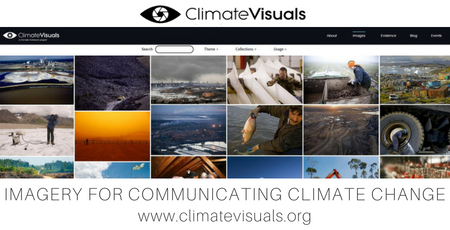Description
The idea that ‘a picture paints a thousand words’ is truer than ever in the digital era, where images and video play a central role in communication and engagement. But until recently, climate communicators have paid very little attention to imagery, with the same cliched pictures appearing again and again (polar bears, smokestacks and melting ice). The Climate Visuals project (led by Climate Outreach) aims to solve this problem by catalysing a new visual language for climate change that focuses on the diverse human stories at the centre of the climate change challenge.
Based on international social research with over 3000 people, we developed a set of 7 core principles for more effectively communicating climate change through imagery. Based on these principles - which include the importance of showing real people affected by and responding to climate change, rather than polar bears and protesters - we produced a website (www.climatevisuals.org) which contains a growing library of climate images that point the way to a new visual language for climate change. Every image is captioned to explain why it 'works', providing inspiration and guidance to campaigners, picture editors, journalists and communications practitioners choosing imagery for communicating climate change.
Since launch, we have experienced what a great appetite there is from organisations to better communicate climate change to their audiences. The new website was launched on 1st May and there have been over 8,000 users from close to 60 countries worldwide, with regular feedback on how people are using the resource to inform their work. This has included a range of NGOs such as WWF, Tearfund, Mission 2020, CAN international, international universities, IPCC, US Global Change Research Programme and many more.
But core funding for this pioneering programme ends in early 2019, and new funding is required to ensure that this valuable and unique resource is sustained and can continue to support positive communications practices among partners and users around the world.
More information:
- Climate Visuals Report: 7 Principles for Climate Change Communication: http://www.climatevisuals.org/sites/default/files/2018-03/Climate-Visuals-Report-Seven-principles-for-visual-climate-change-communication.pdf
- Video introduction to the website: https://youtu.be/b-XKOl_OCbk
- Video introduction to the Climate Visuals project: https://youtu.be/5bvCO9FFU9
Objectives and beneficiaries
Objectives:
- To catalyze a new visual language for climate change at an international level;
- To sustain a dynamic, useful and relevant online resource by increasing the Climate Visuals image library in line with the 7 principles.
Beneficiaries:
- Our global target network and existing website users, (including NGOs, academic institutions, policy organizations, and media outlets), who are using the Climate Visuals image library and drawing on the Climate Visuals research in their communications work
Ultimately our aim is to catalyze a new visual language for climate change and convey the urgent and diverse reality of climate change to everyone - not the already converted. We are able to amplify our aim/reach via our global network of users - as they take on the learning and approach of Climate Visuals to communicate with their own audiences.
Strong points of the solution
Climate Visuals:
- Fills a key gap in the climate communication field;
- Addresses the urgent need to communicate beyond the converted and highlight climate change’s relevance to us all - at a local level and not just in distant ‘other’ places;
- Provides evidence-based imagery for effective visual communication;
- Has a proven existing user base and an influential network of users;
- Is a free and easily accessible resource for any and all at an individual and professional level.
Another strength of the Climate Visuals resource is that it ‘amplifies’ the award on offer because the website is a tool that key influencers around the world are already engaging with. We will be able to ensure that it continues to be relevant and reaches further.
Expected results and benefits for climate change adaptation and mitigation
Since launch, we have experienced what great appetite there is from organizations to better communicate climate change to their audiences. The new website was launched on 1st May and there have been over 8,000 users from close to 60 countries worldwide, with regular feedback on how people are using the resource to inform their work. This has included a range of NGOs such as WWF, Tearfund, Mission 2020, CAN international, international universities, IPCC, US Global Change Research Programme and many more.
Our resource provides inspiration to a huge range of practitioners and communicators from all variety of organizations, from individuals and grassroots all the way through to government level. This reach across the range of influencers is key to communicating and catalyzing a new visual language for climate change. As we move closer to a 1.5-degree world, there is a growing need to communicate the message more widely about the impacts, the solutions, adaptations, and mitigations to climate change.
Scalability potential of the solution
Scalability is central to Climate Visuals. We began with a small library of 100 images, and now through partnerships with agencies and photographers, we have close to 600. As the project grows and continues, so we hope will the number of images in the library, and our recently revamped (fully searchable) website means that we can add many thousands of images over time.
By partnering with international photo agencies to showcase their photographers’ imagery on our website we are also engaging them in the debate and about the importance of showing more diverse climate change imagery. This has had profound results, such as our partnership with Aurora; they changed their ‘climate change’ search function, on the basis of the 7 Climate Visuals principles, to show the full breadth of the climate change challenge - a move away from the from the historic search results which comprised mostly of ice sheets and polar bears.
[Editor's Note: All information published as submitted by the author(s). Minor edits may have been made for length and clarity.]







